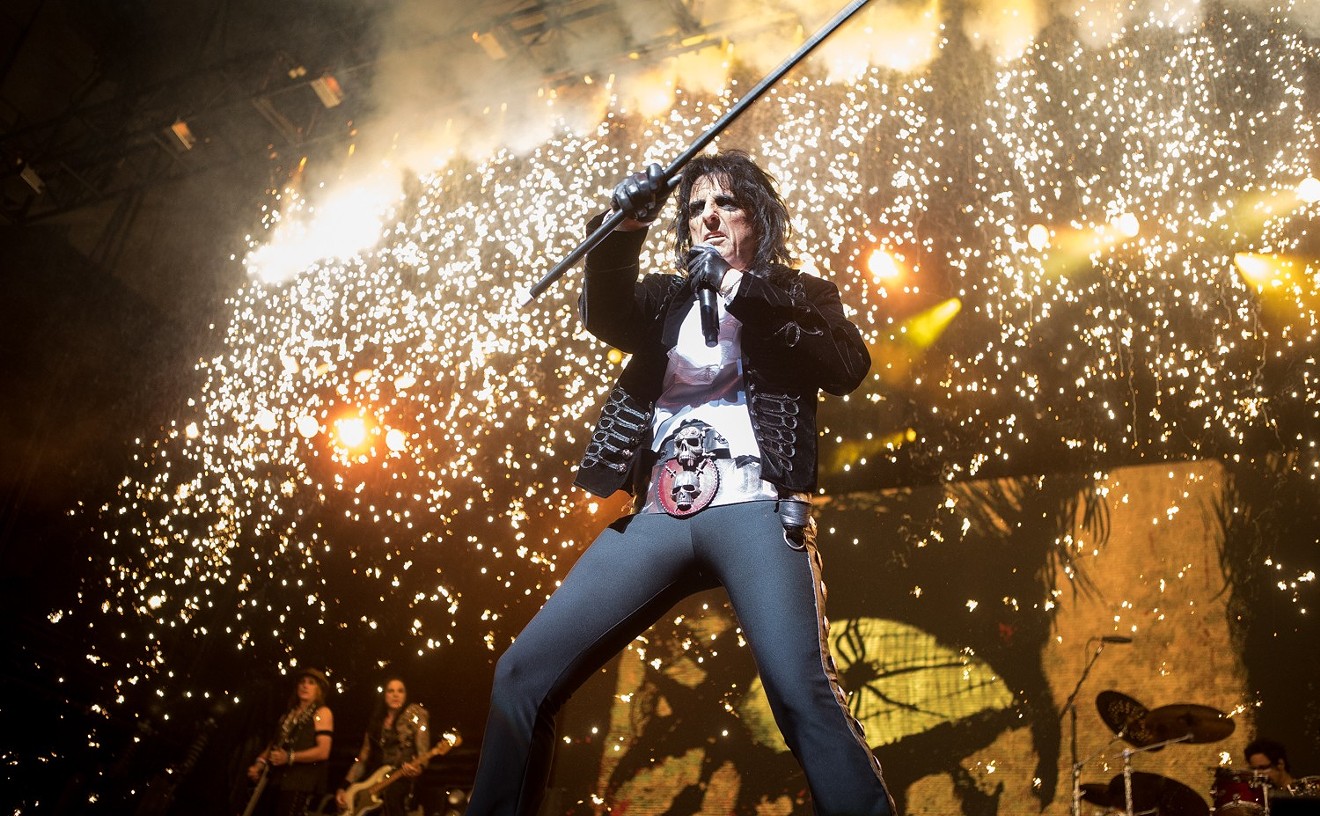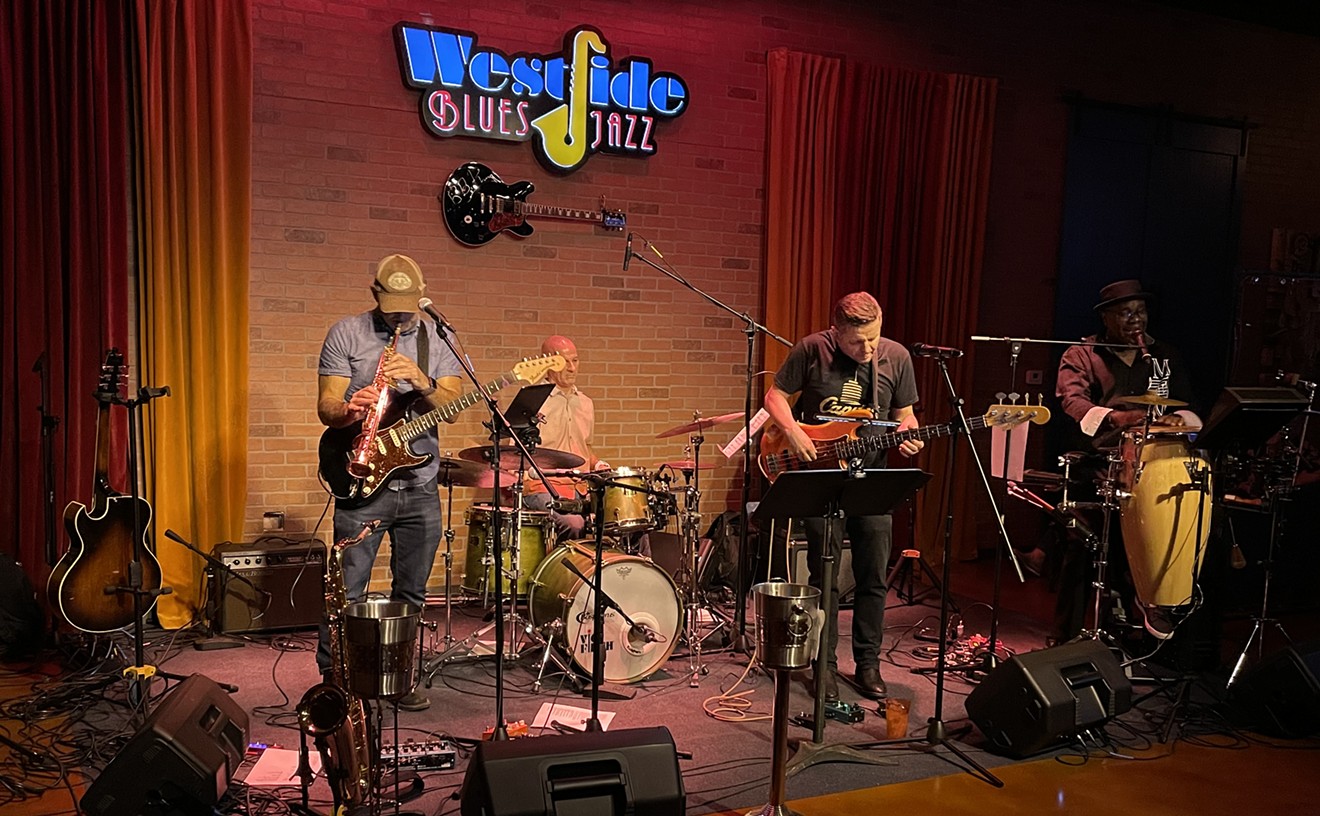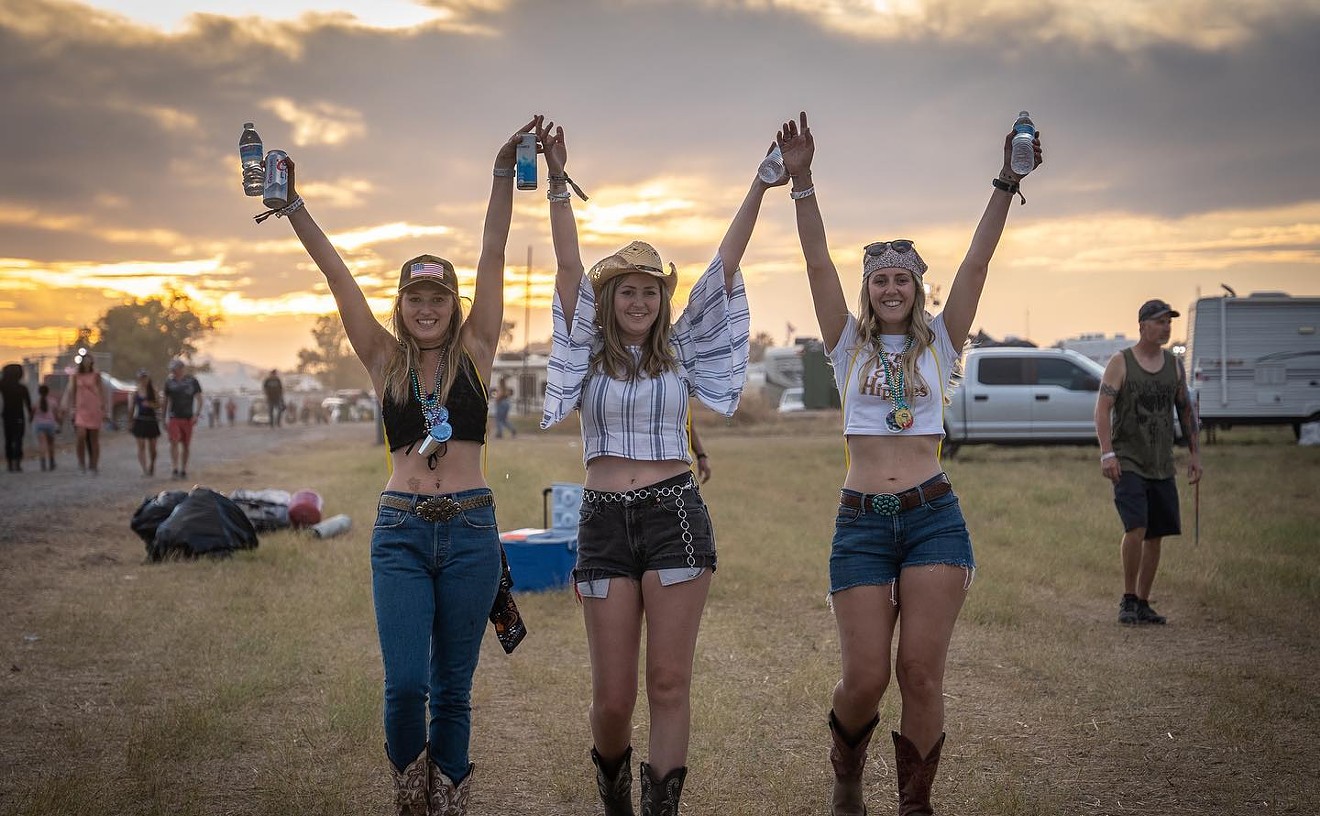But the 61-year-old guitar legend isn't plugged into an old Fender tube amp. His custom Gibson L-5 guitar is nowhere in sight. No, he's idly swaying on a swing in front of Papa's Place, the preeminent--and possibly only--diner in Cordes Junction, a ghost of a trailer-park town about an hour north of Phoenix. Casey moved here in March when a friend offered him a place to stay after he'd had a falling-out with his Phoenix roommate.
Casey concedes that he misses life in the city, but he's taken to the weather in his new home. "It's 10 to 12 degrees colder here than in Phoenix," he says, tugging at his maroon jacket.
He seems surprisingly unmusicianlike. With thinning gray hair and thick spectacles, and decked out in a dark-green striped shirt, grayish pants and white sneakers, he looks vaguely like a retired social-studies teacher getting set to play a round of golf. No one would guess that this man's astounding musical virtuosity played a monumental role in the shaping of pop music in the '50s and '60s.
But then that's always been Al Casey's curse. As his ex-producer Lee Hazelwood once said, as a means of explaining why he'd pushed to make a star of Casey's friend Duane Eddy rather than Casey himself: "Duane was a lot better looking than Al, who wore glasses and was so fat at that time that I once bought him logs to put under the seat of his Ford to hold the springs up."
In short, Al Casey had a face made for radio, at a time when even radio wouldn't accept an ungainly pop star. But Casey was always more comfortable standing in the shadows of stardom anyway, lending his finely honed instrumental skills to a cornucopia of hit records. Along the way, he was one of the key players who helped turn Phoenix from a sleepy desert town into a player on the national music front.
Casey was born in Long Beach, California, in 1936 and moved to Phoenix two years later. His dad played guitar and tried to get Al started on the instrument at age 6, but his fingers were still too small, so he switched to ukulele. At 8, Casey picked up the steel guitar and got into the country-style picking that was all the rage in Phoenix at the time.
By the time he reached his late teens, he was playing five or six nights a week in local dives. "You could actually make money playing clubs back then," he says. Along the way, he crossed paths with an ambitious Coolidge radio DJ named Lee Hazelwood, who was looking to strike gold as a record producer. In 1956, Hazelwood was seeking a singer for a country-oriented tune he had written, called "The Fool." Casey not only suggested a singer, his friend Sanford Clark, but also contributed a crucial R&B guitar lick to the recording. The result was a No. 9 hit on the national pop charts, and the birth of a Phoenix scene.
After numerous other attempts at a breakthrough success--including some with Casey--Hazelwood found his dream artist in the person of Duane Eddy, a shy, matinee-idol-handsome, Chet Atkins-worshiping guitarist. Hazelwood convinced Eddy to drop the Atkins style and play melodies on the low strings of his guitar. Since there was no room for another guitarist at Eddy sessions, Casey played piano in the studio. The result of Hazelwood's efforts was the instrumental "Movin' and Groovin'," which began an unmatched string of chart successes for Eddy.
Of course, Eddy wasn't playing anything that Casey couldn't do in his sleep and with one hand tied behind his back. In fact, Casey's tastes were so eclectic and the scope of his talent so wide, this twangy instrumental phase of his career looks like a mere amusing diversion.
"Al was much more versatile than that," says John Dixon, a Phoenix music historian and co-author of a definitive Duane Eddy biography. "It was a sound that Lee Hazelwood wanted, and Al was the first guy that could do it in a style that seemed to satisfy Hazelwood. And Al did some acetates that Duane Eddy studied to get the sound."
In fact, the year before Eddy's breakthrough, Casey had recorded a twangy rocker called "Ramrod," which anticipated the Eddy style. When Eddy played the song on American Bandstand in 1958, requests flooded in for a single. Eager to get the song in record stores right away, Hazelwood--apparently over Eddy's objections--released Casey's year-old recording under the name of Duane Eddy, and it became one of the biggest hits of Eddy's career. It remains such a source of embarrassment for Eddy that he continues to dispute this account of the story, despite the unanimous agreement of all the other participants involved.
Al Casey prefers not to talk publicly about "Ramrod." He doesn't want to hurt his old friend, and, besides, he doesn't care that much about the glory. Even the brief, fertile solo career he had in the early '60s means less to him than his 18 years in Los Angeles as part of the ace studio session group known affectionately as the Wrecking Crew.
Casey gets particularly excited talking about an upcoming project involving the old members of the Wrecking Crew.
"I'm flying over to L.A. Sunday," he says. "A couple of guys from New York are doing a documentary. It should be great. It's gonna be called Session Men, and it's about all the guys in L.A., Muscle Shoals, Nashville and New York. The main thing it's gonna center on in L.A. is how with groups like the Beach Boys, that it really wasn't them playing on the records, it was us. It's gonna be a little reunion. It'll be great to see the guys again."
Casey moved to L.A. in 1965 after making studio contacts there through his work with Eddy. Almost immediately, his versatility set him apart from a slew of session players. He could, on command, shift from jazz to country to rock to straight pop. In a given week, he might play for artists as diverse as Frank Sinatra, the Association, the Beach Boys, the Fifth Dimension, Glen Campbell, Dean Martin. He could go from the sublime (Pet Sounds) to the ridiculous ("These Boots Are Made for Walkin'") and leave his stamp on even the most lavish productions ("MacArthur Park"). Also, unlike some of the other studio top dogs, he could read music.
"There were people who couldn't, like James Burton and Glen Campbell," he says. "For my particular work, it was to my advantage, 'cause James, for instance, for what he does he's the best, but that's basically all he can do. He doesn't need to do anything else, by the way.
"But I have been on sessions where I had to end up playing the part, 'cause it was written down and James couldn't play it. I ended up being kind of a utility player; I played a lot of different styles, a lot of different instruments. I played banjo, mandolin, a little steel."
Asked if he played the strangely incongruous banjo parts on the Pet Sounds track "I Know There's an Answer," he confesses that he can't remember which parts are his on the album. After all, at the time, it seemed just another session for Casey. He does recall, however, that Brian Wilson was a rare, eccentric bird in the slick L.A. studio world.
"He'd hand you a blank piece of manuscript and then he'd start telling you what he wanted you to play," Casey says. "I forget how many sessions we did with 'Good Vibrations.' One time, we went in and cut eight bars, for a whole session.
"[Wilson] did some off-the-wall things, even before he slipped over the edge. We were doing a session one day, and there was a coffee shop about half a block away, and he sent a secretary over there to rent some pots and pans for the session, just to beat on them and get some sounds. The funny thing, typical Hollywood, is that they rented them."
Casey played on such Sinatra megasellers as "Strangers in the Night" and "That's Life," and says that Ol' Blue Eyes' concerted efforts to meet and greet all the session players motivated the most hardened studio pros to "bust your ass for him." By contrast, Dean Martin--for whose TV show Casey spent three and a half years working--would casually wave and say hello to the musicians, always friendly without exerting too much effort.
At his peak, Casey worked two to three sessions a day, and ran a music store called Al Casey's Music Room. Though in retrospect he and his peers seem to have been underpaid, he says they never thought that way at the time.
"I talked to the [documentary filmmaker] last night, and he said, 'It's a shame you only made $61.50 a session.' For three hours, we were glad to get it, are you kidding? He did point out one thing, though. Prior to that period, when a studio musician went in, you were just required to read the music, play your part and keep your mouth shut. And long about then is when they started wanting musicians to be creative, and they started drawing on our creative talents."
Casey had a great run in L.A., but session work eventually started to dry up. "I left there in '83 and it had already started changing," he says. "'Cause what happens, especially with rhythm sections, is that they want younger guys. Because, let's face it, young guys come up with new sounds."
In 1983, Casey moved back to Phoenix, where he gave guitar lessons off and on, and played the occasional show. Today, he describes himself as "semiretired," but he still plays from time to time, including an annual performance at the Rhythm Room. Two years ago, the German label Bear Family Records asked him if it could release some of his old solo stuff, which included surf singles like "Thunder Beach" and "Surfin' Hootenanny" (a No. 48 pop single in 1963) as well as some quirky lounge-jazz tunes he cut in the early '60s.
Casey had another idea. Would they be interested in a new Al Casey album?
Of course, they said yes, and the result, Sidewinder, might be as close as we'll ever get to a single album that touches on all the different strains of music that pass through Casey's fluid fingers. Jamming with old friends like Glen Campbell and new friends like David Grisman, Casey pulls off a coup much like what Charlie Rich achieved in 1993 with Pictures and Paintings: an album that gracefully bridges all elements of a wildly eclectic career.
Sidewinder closes with a remake of "The Fool," the song that launched Casey's career. With Lee Hazelwood at the mike, Casey reprises the song's spiky, signature riff and brings his career full circle. The overall effect of the album is to make you wonder if Casey would have liked more chances to be the front man, instead of the virtuoso in the shadows. He insists he has no regrets.
"I would never consider trying to sing, and instrumentalists haven't made it for a long time," he says. "And I was around it enough. I had my share of it."
Al Casey is scheduled to perform on Tuesday, November 25, at the Rhythm Room. Showtime is 9 p.m.










